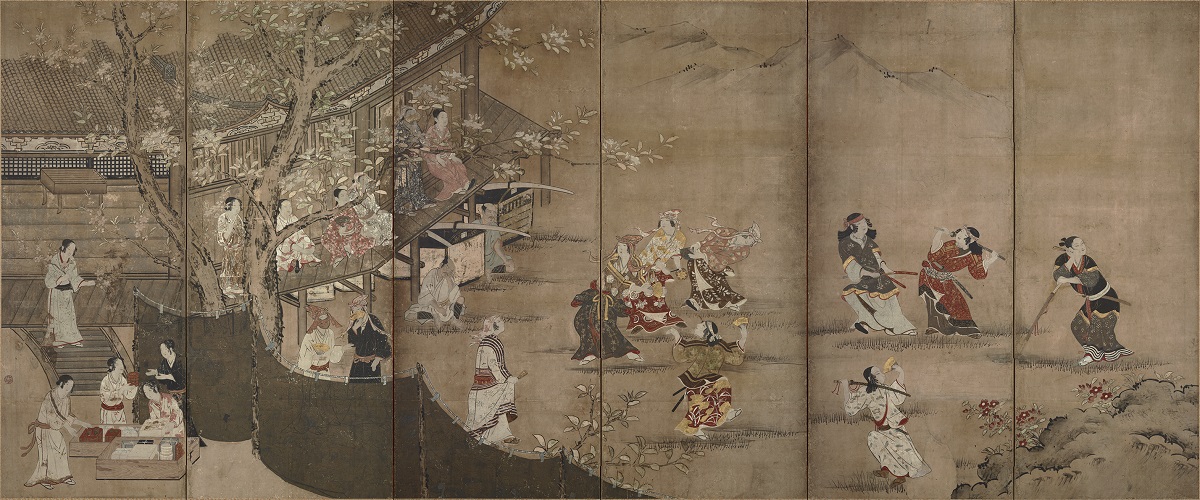In this installment of the “10 Charismatic Painters: An Introduction to Japanese Art” series, in this issue, we introduce Kano Eitoku(狩野永徳), along with his representative works.
[Aha! the True History of Japanese Art]
Lost in the fire…
Eitoku, born as a heir to the Kano school, was recognized as a gifted painter at an early age, and thus received the best education to become the best of the best.
At the young age of 23, Eitoku who had demostrated his outstanding painting ability by completing ‘Rakuchu Rakugai zu Byobu Uesugi bon(洛中洛外図屛風 上杉本)’ was given the position of chieftain by his father Shoei, the third head of the Kano school, and succeeded as the fourth generation at a remarkably young age.
The new Kano school led by Eitoku was ordered by Nobunaga Oda, who had built Azuchi Castle, and Nobunaga was pleased with Eitoku’s paintings of the ‘Shosho hakkei(瀟湘八景)’, ‘Katyou(花鳥)’, and ‘Syaka jyudai deshi(釈迦十大弟子)’.
Eitoku, who was also valued by Toyotomi Hideyoshi, is said to have received favorable reviews for his paintings on the walls of Osaka Castle and Jurakudai(聚楽第), both of which were destroyed by fire during the war. This was a great loss for Japanese art.

[Aha! the True History of Japanese Art]
Beloved by two great generals, Nobunaga Oda and Hideyoshi Toyotomi
Although Eitoku gained fame first and foremost because of his own talent, it is impossible to talk about Eitoku without mentioning that he was taken up by Oda Nobunaga.
It is thought that they met in “Rakuchu Rakugai zu Byobu Uesugi bon”, and perhaps the wills of those who had been vying for power in their respective worlds were communicated, Nobunaga appointed Eitoku as a painter to hold his hand. Nobunaga appointed Eitoku as his chief painter. He entrusted Eitoku to paint the walls of Azuchi Castle and other buildings that he had him build to show off his power, and gave him the top position as a painter.
Hideyoshi, who succeeded Nobunaga, also entrusted Eitoku with the painting of massive works of architecture such as Jurakudai and Osaka Castle. Eitoku was extremely busy and had no time to paint detailed pictures, so he shifted to “Taiga” in which he painted huge motifs on a large canvas. This led to masterpieces such as ‘Karajishi zu Byeobu(唐獅子図屛風)’ and ‘Hinoki zu Byobu(檜図屛風)’.

Kano Eitoku, National Treasure, Colored on gold on paper, Azuchi-Momoyama period, dated 1590 170.0cm(T) x 230.4cm(W) Tokyo National Museum Source: ColBase (https://colbase.nich.go.jp)
The bold form of the large cypress tree with its undulating trunk and swinging branches and the intense colors fully embody the aesthetic sensibilities of the time. It is believed to have been a sliding door painting that decorated the residence of Hachijo no Miya (later Katsura no Miya ke), which was completed in 1590 (Tensho 18), and is considered to be Eitoku’s last work.
[Aha! the True History of Japanese Art]
Laying the Foundations for 300 Years of the Kano School
The Kano school, founded by Masanobu in the late Muromachi period (1336-1573), was organized by Motonobu, the second generation, and reached its peak with Eitoku, the fourth generation.
However, Eitoku’s health failed due to his busy schedule, and he died suddenly at the age of 48. The unexpected death of a genius painter threatened to shake the very foundation of the Kano school. However, contrastingly eldest son Mitsunobu, his second son Takanobu, his younger brother Naganobu, and their pupils Yamaraku and Naizen were active in the Kano school, serving as official painters for Toyotomi and Tokugawa at a time when the two schools were in rivalry with each other, and the power of the school grew rather rapidly. Furthermore, Takanobu’s eldest son, Tanyu, a genius who was called the second coming of Eitoku, went to Edo as an official painter for the Tokugawa Shogunate, and Sangaku, who inherited Eitoku’s style, continued the lineage as Kyogano.
Eitoku’s successor, Yamaraku, inherited Eitoku’s style and continued the lineage as the Kano school.

Kano Naganobu, National Treasure, Edo period, 17th century 148.6 cm (H) x 355.8 cm(W), Tokyo National Museum Source: ColBase (https://colbase.nich.go.jp)
This is a national treasure Byobu of Naganobu, Eitoku’s younger brother, who inherited Eitoku’s painting style.

Kusumi Morikage, National Treasure, Ink painting on paper, light color, 2 kyoku, 1 screen, Edo period, 17th century, 149.1 cm(H) x 165.0 cm(H), Tokyo National Museum Source: ColBase (https://colbase.nich.go.jp)
Morikage was one of the Four Heavenly Kings under Kano Tanyu. The peaceful atmosphere of a family of three enjoying the cool evening under a shelf of evening glories is soothing.
Profile of the charismatic painter Kano Eitoku
Kano Eitoku
1543-1590. Born in Kyoto as the eldest son of Shoei, the third generation of the Kano school, Eitoku was praised as a genius from early on, and distinguished himself with the orthodox style of the Kano school. As a young man, he demonstrated his ability in detailed depiction, and as he became extremely busy as the head of the Kano school, he developed his own unique style of painting, including large and bizarre styles.
*This article is a reprint of the magazine Waraku (April/May 2018).
This page is translated from: https://intojapanwaraku.com/art/218822/


























